Protein
Adequate protein intake is essential to help minimise declines in strength and function.44 High protein supplements can help reduce complications and improve weight.45
Muscle strength is vital for patients’ quality of life and can help lead to improvements in lifespan and overall health, independence and functionality.2
Skeletal muscle is an important regulator of energy and protein metabolism. It plays an important structural role, supporting strength, movement, and balance. Muscle also has an important metabolic role, storing proteins and amino acids, regulating glucose levels, producing antibodies and hormones, and supporting thermogenesis.3
Maintenance of the protein content of certain tissues and organs, such as the skin, brain, heart, and liver are essential for survival. In the post-absorptive state, these organs rely on a steady supply of amino acids via the blood to support muscle synthesis and balance protein breakdown.1
The Importance of Protein for Muscle4,5

Builds muscle
providing strength and mobility

Repairs tissue
healing wounds and keeping skin healthy

Produces hormones and enzymes
regulating body processes and chemical reactions

Makes antibodies
helping to fight infections and diseases

Supports bone and joint health
building muscle and reducing the risk of falls
In healthy muscle, there is a balance between protein synthesis and breakdown. However, when a patient is experiencing metabolic stress, caused by ageing, injury, inflammation and illness, the body metabolises muscle to release energy, leading to muscle loss.3,6
Muscle Strength Over a Lifetime
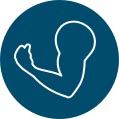
Muscle mass decreases naturally with age.7-9

As part of the natural ageing process, sarcopenia — a progressive and generalised skeletal muscle disorder — occurs7,10

This can lead to physical frailty7

It can also lead to increased risk of morbidity and mortality.7
Although muscle loss is a natural consequence of ageing, loss of muscle mass/function can be seen as early as the age of 30.11,12
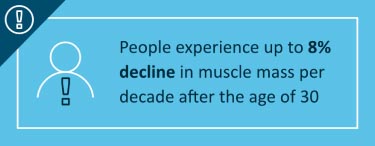

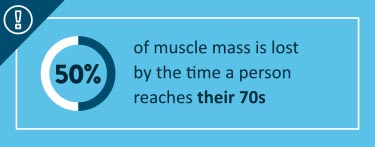

Muscle loss can have devastating consequences for patient outcomes, including:3,13
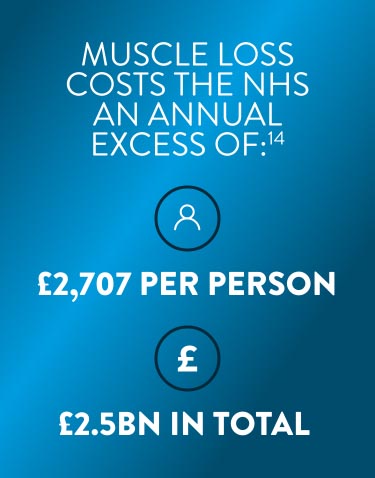

In a stressed state, the body requires more amino acids from muscle breakdown, leading to accelerated protein loss. Patients with low muscle mass have difficulty coping with metabolic stress, negatively impacting survival, and recovery, especially if they have a long-term condition, such as cancer.1
Extended periods of immobilisation, such as during acute hospitalisation, can worsen muscle loss and prolong recovery. If muscle loss persists before the body enters a stressed state, restoring normal function becomes unlikely.1


The importance of muscle for cancer patients
Following a cancer diagnosis, up to 70% of cancer patients experience loss of muscle.15 Evidence shows that cancer patients with pre-treatment weight loss have shorter survival rates and poorer prognosis.16-18
Early assessment and intervention for malnutrition and muscle loss in cancer patients can counteract muscle wastage and prevent cancer cachexia.19


The importance of muscle for COPD patients
Patients with COPD commonly face muscle weakness and reduced respiratory muscle endurance due to factors such as prolonged use of COPD medication, hypermetabolism and other comorbidities, which can impact their outcomes.20-27
Muscle loss can worsen with disease severity but can affect even stable patients.28 Such changes can also influence disease trajectory, so early assessment and intervention are critical to improve patient outcomes.29


The importance of muscle for healthy ageing in frail and pre-frail patients
Malnutrition, sarcopenia, and frailty commonly coexist in the elderly, with a complex relationship where each condition can accelerate the progression of the others. Frail and sarcopenic patients are at an increased risk of malnutrition and muscle loss, which, in turn, can escalate the progression of frailty.30,31
Although frailty and declining physical function are associated with increased age, promoting healthy ageing from middle age onwards could delay the onset of frailty as people grow older.32
Muscle loss and sarcopenia are reversible with early nutritional intervention and treatment.33,34 Although muscle wasting often leads to frailty, particularly in older patients, frailty too can be treated if early identification and intervention take place.34,35
Muscle loss, sarcopenia and frailty can be reversed with early nutritional intervention and treatment.33,36
However, once a patient becomes cachexic – where muscle loss is accompanied by progressive weight loss – nutritional interventions alone cannot reverse it, which can affect the quality of life and survival rates for patients with chronic diseases.37,38
Muscle screening and assessment are recommended by the European Working Group on Sarcopenia in Older People (EWGSOP2), The European Society for Clinical Nutrition and Metabolism (ESPEN), and The European Respiratory Society (ERS).39-41 They often take limited time to apply in clinical practice and are typically non-invasive, inexpensive and convenient for the patient.10,42
Screening for muscle loss can easily identify limited strength and performance, a strong predictor of adverse negative health outcomes and can be easily used to increase physical activity and implement nutrition interventions.42,43
Various reliable screening methods exist to assess the risk of malnutrition and muscle loss.10
Vital nutrients can improve muscle health:
Adequate protein intake is essential to help minimise declines in strength and function.44 High protein supplements can help reduce complications and improve weight.45
HMB is a metabolite of leucine, a branched-chain essential amino acid exclusively obtained from dietary sources.46
Vitamin D acts directly on muscle to promote its function through specific vitamin D receptors found on muscle cells.47 It plays an important role in maintaining musculoskeletal health and can help reduce the risk of falls and improve mobility.48-50
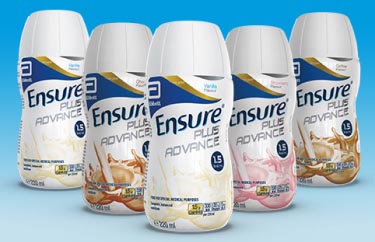

Ensure Plus Advance§ is a 220ml, ready to drink ONS. It contains a unique blend of protein, vitamin D and HMB that improves patient strength, increases body weight and reduces the risk of mortality.°,51 It is the high protein, high energy ONS people prefer to drink vs. market-leading high protein compact*,†,52,53 and achieves 96% compliance.^,54
Validated by more than 18 clinical studies,51,54-72 Ensure Plus Advance is clinically proven to significantly increase muscle strength, mobilisation rates and wound healing and has also been shown to improve patients’ quality of life.**,††,‡‡,§§,¶,¶¶,~,#,51,54,58-60,62,65,67
The unique blend of protein, vitamin D and HMB in Ensure Plus Advance is clinically proven to improve strength and shorten immobilisation periods.§§,||,62,66
Abbott’s range of ONS has been developed to help patients with other nutritional needs.
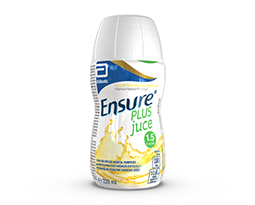
Ensure Plus juce
Ensure Plus juce is a 1.5 kcal/ml, ready-to-drink, juice style oral nutritional supplement for people with, or at risk of developing, disease-related malnutrition. Ensure Plus juce is best served chilled and is available in six flavours: apple, fruit punch, lemon and lime, orange, peach and strawberry. It's presented in a 220 ml bottle with a peel-off seal for pouring.
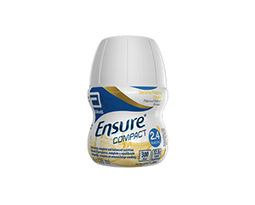
Ensure Compact
Ensure Compact is a 125 ml, ready-to-drink, nutritionally complete§ oral nutritional supplement for people with, or at risk of developing, disease-related malnutrition. Its small volume has been specially developed for people who have difficulty drinking larger volumes or who have a poor appetite. Each easy-to-open Ensure Compact bottle1 provides 300 kcal (2.4 kcal/ml) and 12.8 g of protein.
Ensure Compact is available in 4 delicious flavours; banana, café latte, strawberry and vanilla.
§Nutritionally complete for vitamins and minerals in 625 ml (excluding sodium, potassium, chloride and magnesium). Calculated using the UK Reference Nutrient Intake for men aged 19-50 years.
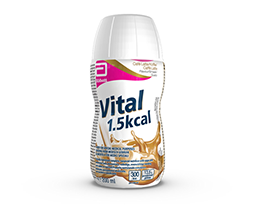
Vital 1.5kcal
Vital 1.5kcal is suitable for people with disease-related malnutrition and malabsorption or for those who experience symptoms of poor feed tolerance. Vital 1.5kcal is peptide-based* and available both as a 200 ml oral nutritional supplement, and as a 1000 ml Ready to Hang tube feed, both of which attach directly to Abbott giving sets. Oral nutritional supplement flavour options include: café latte, mixed berry and vanilla.
*Peptides are partially broken down proteins, which makes them easier to digest and absorb in the gut than whole proteins.
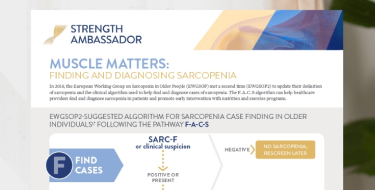

Infographic — Muscle Matters: Finding and Diagnosing Sarcopenia
This infographic displays the 4 steps of the EWDSOP2 clinical algorithm used to help find and diagnose cases of sarcopenia.
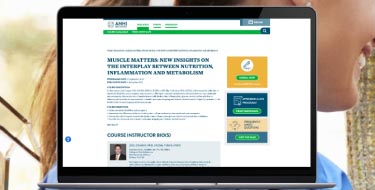

On-demand webinar — Muscle Matters: Insights on the Interplay Between Nutrition, Inflammation and Metabolism
In this video, Joel Cramer, PhD, FACSM, FNSCA, FISSN, and Phillip J Atherton, PhD, AFHEA, present the definition of metabolic flexibility and sarcopenia, discuss the role of muscle in metabolic dysfunction, inflammation, glucose control, and muscle loss in diabetes, and describe the increased risk of insulin resistance in ageing and diabetic skeletal muscle.
UK-N/A-2300359 | November 2023
Footnotes
COPD - Chronic obstructive pulmonary disease. HMB - ß-hydroxy-ß-methylbutyrate. § ACBS indication: as a nutritional supplement for frail elderly people (>65 years of age, with a BMI ≤ 23kg/m2), where clinical assessment and nutritional screening show the individual to be at risk of undernutrition. ° Based on a post-hoc analysis of the NOURISH Study, a multicentre, randomised, placebo-controlled, double-blind trial. The COPD subgroup (n = 214) included hospitalised, malnourished, older adults (≥65 years), with admission diagnosis of COPD who received either standard-of-care plus Ensure Plus Advance] (n = 109) or standard-of-care and a placebo supplement (n = 105) prescribed 2 servings/day from within 3 days of hospital admission (baseline) and up to 90 days after discharge. * Vs. market-leading high protein compact. †243 healthy adults who were asked to drink comparative flavours of Ensure Plus Advance and Fortisip Compact Protein. Approximate values shown. ^ Research with 80 healthy women over 65 years of age supplemented with one serving of Ensure Plus Advance daily for 8 weeks. . ** As shown in a randomised control trial to investigate the effects of the intervention ONS on malnourished, cardiopulmonary patients (≥65 years) vs placebo. The intervention ONS decreased mortality at 90 days post-discharge, however the study did not observe a significant effect for the primary composite endpoint of non-elective readmission or death. This post-hoc, sub-group analysis from the NOURISH study cohort comprised 214 COPD patients. ††Strength was measured by handgrip strength in a post hoc analysis of over 600 malnourished people with heart or lung diseases, age 65 or older. Study product was consumed twice a day for 30 days, as compared to standard of care. ‡‡ In 330 older adults with malnutrition and sarcopenia. Muscle quality was calculated as leg strength expressed relative to the muscle mass. §§ As shown in a randomised controlled trial in which normally nourished patients with non-cystic fibrosis bronchectasis received pulmonary rehabilitation plus a specialised ONS or pulmonary rehabilitation only for 12 weeks. In the intervention group, mean and maximum handgrip dynamometry, physical functioning domain of QOL-B-V3.0 and other outcomes were significantly increased from baseline at 12 weeks and 24 weeks and fat free mass at 12 weeks. ¶ An open-label study of elderly (n=35) patients with recent weight loss (>5% during previous 3 months) showed that 12 weeks supplementation of experimental product twice daily increased dietery intake, biochemical variables, and quality of life compared to baseline. ¶¶ In 65 healthy older female patients who regularly attended a fitness programme. ~ As shown in a randomised controlled trial in which normally nourished patients with non-cystic fibrosis bronchectasis received pulmonary rehabilitation plus a specialised ONS or pulmonary rehabilitation only for 12 weeks. In the intervention group, mean and maximum handgrip dynamometry, physical functioning domain of QOL-B-V3.0 and other outcomes were significantly increased from baseline at 12 weeks and 24 weeks and fat free mass at 12 weeks. # In a single arm open-label study of 148 patients aged 80±8.3 years with or at risk of malnutrition who consumed experimental product twice daily for 12 weeks as compared to baseline. || In 92 patients aged 65 and over with hip fractures admitted to a rehabilitation facility, either receiving a standard diet plus 2 bottles of the study product or a standard diet only. Standard diet provided 1500 kcal, 87.4 g protein a day.
References
1. Wolfe RR. Am J Clin Nutr 2006;84:475-482. 2. McLeod M. et al. Biogerontology 2016;17:497-510. 3. Argiles JM. et al. JAMDA 2016;17:789-796. 4. Wolfe RR. et al. Clin Nutr 2008;27:675–684. 5. Britannica 2020. Special structure and function of proteins. Available online at: https://www.britannica.com/science/protein/Special-structure-and-function-of-proteins Last accessed October 2023. 6. Fry CS. and Rasmussen BB. Curr Aging Sci 2011;4(3):260–268. 7. Wilkinson DJ. et al. Clin Nutr 2018;37(6):2068-2075. 8. Baier S. et al. JPEN J Parenter Enteral Nutr 2009;33(1):71-82. 9. Flakoll P. et al. Nutrition 2004;20(5):445-451. 10. Cruz Jentoft A. et al. Age Ageing 2019;48(1):16–31. 11. Volpi E. et al. Curr Opin Clin Nutr Metab Care 2004;7(4):405-410. 12. Waltson JD. Curr Opin Rheumatol 2012;24(6): 623-627. 13. Demling RH. Eplasty 2009;9:e9. 14. Pinedo-Villanueva R. et al. Calcif Tissue Int 2019;104:137–144. 15. Ryan AM. et al. Proceedings of the Nutrition Society 2016;75:199–211. 16. Grossberg AJ. et al. JAMA Oncol 2016;2(6):782-789. 17. Chang KV. et al. Liver Cancer 2018;7:90-103. 18. August DA. et al. Journal of Parenteral and Enteral Nutrition 2009;3(5):472-500. 19. Dalise S. et al. Eur J Transl Myol 2020;30(2):258-267. 20. Abdulai RM. et al. Am J Respir Crit Care Med 2018;197(4):433-449. 21. Oroxco-Levi M. Eur Respir J 2003;22(46):41s-51s. 22. Malnutrition Pathway, 2020. Managing Malnutrition in COPD: Including a pathway for the appropriate use of ONS to support community healthcare professionals. Available online: https://www.malnutritionpathway.co.uk/library/mm_copd.pdf. Last accessed August 2023. 23. King PT. Clin Transl Med 2015;4:26. 24. Fermoselle C. et al. Eur Res J 2012;40(4):851-862. 25. Jaitovich A. & Barreiro E. Am J Respir Crit Care Med 2018;198(2):175–186. 26. Wüst R. & Degens H. Int J Chron Obstruct Pulmon Dis 2007;2(3):289-300. 27. Passey SL. et al. Pharmacol Ther 2016;116:56-70. 28. Jones SE. et al. Thorax 2015;70(3):213-218. 29. Fekete M. et al. Physiol Int 2021;108(2):238-250. 30. Xue QL. Clin Geriat Med 2011;27(1):1–15. 31. Mühlberg W. & Sieber C. Gerontol Geriat 2004;37:2–8. 32. Gordon SJ. et al. BCM Geriatrics 2020;20:96. 33. Prado CM. et al. J Cachexia Sarcopenia Muscle 2020;11(2):366–380. 34. Wilson D. et al. Ageing Res Rev 2017; 36 1-10. 35. Takatori K. & Matsumoto D. PLoS ONE 2021;16:e0247296. 36. Gao Balch H. Diabetes Updates 2019;5. 37. Ali S. & Garcia JM. Gerontology 2014;60(4):294-305. 38. Scherbakov N. & Doehner W. Journ Cachexia Sarcopenia Muscle 2018;9(7):1189–1191. 39. Cruz-Jentoft AJ. et al. Age Ageing 2010;39,412-23. 40. Muscaritoli M. et al. Clinical Nutrition 2021;40:2898-2913. 41. Marklund S. et al. Int J Chron Obstruct Pulmon Dis 2019;14:1825-1838. 42. Beaudart C. et al. Calcif Tissue Int 2019;105,1–14. 43. Murayama I. et al. Aging Clin Exp Res 2020;32, 913–920. 44. Deutz NE. et al. Clin Nutr 2014;33(6):929-936. 45. Cawood AL. et al. Ageing Res Rev 2012;11(2):278-296. 46. Wilson GJ. et al. Nutr Metab 2008;5:1.. 47. Wagatsuma A. and Sakuma K. Biomed Res Int 2014;2014:121254. 48. European Food Safety Authority. EFSA J 2010;8(2):1468. 49. European Food Safety Authority EFSA J 2011;9(9):2382. 50. Zhu K. et al. J Am Geriatr Soc 2010;58(11):2063-2068. 51. Deutz NE. et al. Clin Nutr 2021;40(3):1388-1395. 52. Data on file. Abbott Laboratories Ltd, 2023 (Ensure Plus Advance acceptability and compliance vs Fortisip Compact Protein). 53. IMS Data, July 2023. 54. Berton L. et al. PloS one 2015;10(11):e0141757. 55. Ashkenazi I. et al. Geriatr Orhop Surg Rehabil 2022;13:21514593221102252. 56. Chavarro-Carvajal DA. et al. Clin Nutr ESPEN 2022;48:291-297. 57. Cornejo-Pareja I. et al. Nutrients 2021;13(12):4355. 58. Cramer JT. et al. JAMDA 2016;17(11):1044-1055. 59. De Luis DA. et al. Eur Geriatr Med 2018;9(6):809-817. 60. De Luis DA. et al. Nutr Hosp 2015;32(1):202-207. 61. Deutz NE. et al. Clin Nutr 2016;35(1):18–26. 62. Ekinci O. et al. Nutr Clin Pract 2016;31(6):829-835. 63. Espina S. et al. Nutrients 2021;13(11):3764. 64. Lopez-Rodriguez-Arias F. et al. Support Care Cancer 2021;29(12):7785-7791. 65. Matheson EM. et al. Clin Nutr 2021;40(3):844-849. 66. Malafarina V. et al. Maturitas 2017;101:42-50. 67. Olveira G. et al. Clin Nutr 2016;35(5):1015-1022. 68. Peng LN. et al. J Nutr Health Aging 2021;25(6):767-773. 69. Previtali P. et al. Ann Surg Oncol 2020;27(6):2025-2032. 70. Ritch CR. et al. J Urol 2019;201(3):470–477. 71. Standley RA. et al. J Gerontol A Biol Sci Med Sci 2020;75(9):1744-1753. 72. Zana S. et al. J Am Med Dir Assoc 2021;22(7):1358-1360
You are about to exit for another Abbott country or region specific website.
Please be aware that the website you have requested is intended for the residents of a particular country or region, as noted on that site. As a result, the site may contain information on pharmaceuticals, medical devices and other products or uses of those products that are not approved in other countries or regions.
The website you have requested also may not be optimised for your specific screen size.
Do you wish to continue and exit this website?
UK-N/A-2200465 | July 2022
UK-N/A-2200443 | June 2022
Stay Connected